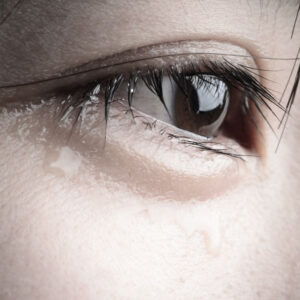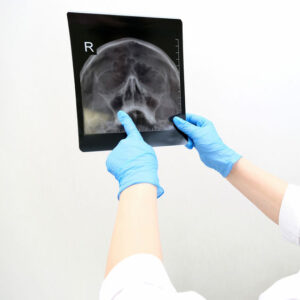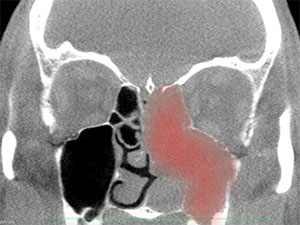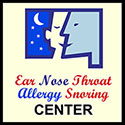Sinus Conditions
 Sinus Problems
Sinus Problems
Sinusitis, allergic rhinitis, viral upper respiratory infections, and more can share similar symptoms such as nasal congestion, excessive or discolored drainage, sinus pressure or headaches, smell loss, and more. Take the guesswork out of determining the best treatment options by consulting with a Fellowship-trained Rhinologist (Sinus Specialist). Following a quick in-office CT scan of your sinuses and occasionally the use of a camera to see the inside of your nose, your sinus expert can help uncover the underlying causes of your bothersome symptoms and suggest an appropriate treatment plan that may range from adjusting or adding medications to considering procedures when medications fail. Procedures offered by our Rhinologist range from minimally-invasive in-office balloon sinuplasty to even the toughest revision sinus surgeries. Avoid the pitfalls of frequent antibiotics, steroid pills, and other ineffective long-term therapies for sinusitis. More importantly, avoid undergoing multiple ineffective procedures in search of lasting relief. Consult with our sinus expert for the very best in sinus care.
Learn more about Sinus Infections
Sinusitis Overview
 Nasal Obstruction
Nasal Obstruction
Nasal congestion or obstruction can result from swollen or enlarged turbinates, deviated nasal septum, nasal polyps, tumors, foreign bodies, and more. Obstruction symptoms are often worse at night while lying down and may contribute to snoring, sleep apnea, and intolerance of CPAP therapy. Swollen nasal passages can often breath better with regular usage of nasal steroid sprays such as Flonase (fluticasone); however, fixed anatomical problems such as a deviated septum may require surgical intervention for relief. Our experts will diagnose the exact causes of nasal obstruction using in-office CT scans or looking with a camera inside of your nose and recommend appropriate treatments that restore your nasal breathing to the best it can be.
 Allergies and Rhinitis
Allergies and Rhinitis
Chronic rhinitis resulting from allergies, airborne irritants, overuse of decongestant medications (such as Afrin), and other sources of inflammation in the nose may lead to persistent drainage, congestion, and many other upper airway symptoms. As these symptoms often overlap with other conditions such as chronic sinusitis, it is important to accurately determine the cause and extent of such conditions before deciding on a treatment approach. We offer imaging to evaluate symptoms (in-office CT scans), nasal endoscopy, allergy testing, and a detailed discussion of your history to fully understand your condition before recommending any treatments such as allergy shots, drops, medications, or procedures. Consult with our experts to ensure accurate diagnosis and optimal treatment of any nasal condition, including chronic rhinitis.
 Nosebleeds (Epistaxis)
Nosebleeds (Epistaxis)
Recurring nosebleeds often result from dry, irritated mucosal lining within the nasal passages. Occasionally, they result from the use of nasal steroid sprays, trauma to the nasal tissues (including nose picking), tumors in the nose, or abnormally superficial blood vessels within the nasal lining. While most nosebleeds are mild and may not require a doctor visit, they can be life-threatening in severe cases. They can also reflect more serious underlying problems, as in the case of bleeding tumors that tend to cause nasal obstruction and bleeding more prominent on one side of the nose. Consult with a Rhinology expert to uncover the exact cause of recurring or severe nosebleeds and determine the best treatment strategy.
 Smell Dysfunction
Smell Dysfunction
Smell function is often compromised when the nose is swollen or inflamed. In this setting, the sense of smell improves with treatment of the underlying condition (sinusitis, allergies, etc.). However, loss of smell can also result from viral respiratory illness (as seen with COVID-19), head trauma, and tumors or lesions within the head. If you are suffering from anosmia (complete loss of smell) or hyposmia (partial loss of smell), consult with a Rhinology expert to ensure an accurate diagnosis and optimal treatment strategy.
 Excessive Tearing (Epiphora)
Excessive Tearing (Epiphora)
Tears normally drain into the nasal passages through a duct beginning near the inside corner of the eye (the nasolacrimal duct). When the flow of tears into the nose is compromised by inflammation, swelling, scarring, or compression by nasal polyps or tumors, you may notice tears leaking down your face similar to crying. Some conditions such as allergies or exposure to eye irritants may also increase tear production temporarily. A Rhinologist can help determine the reason for excessive tearing and suggest the most appropriate treatment for this condition, which may require a specialized endoscopic nasal procedure (Dacryocystorhinostomy, or DCR) to correct the flow of tears into the nasal passage.
 Cerebrospinal Fluid Leak
Cerebrospinal Fluid Leak
Cerebrospinal fluid (CSF) is the clear, salty liquid surrounding and protecting the brain within the skull. CSF leakage into the nose or sinuses can place a patient at risk for chronic or recurring headaches, neurologic symptoms such as seizures, or even infection spreading to the brain or surrounding structures. Causes of CSF leaking from the nose (CSF rhinorrhea) include head trauma, skull base injury during sinus or nasal surgery, spontaneous leakage due to elevated intracranial pressures, and more. In contrast to a nasal drip caused by chronic rhinitis, CSF leakage is often positional (worse while leaning forward with head down) and may drip continuously while in this position or while straining. Accurate diagnosis requires collection of fluid to test for a protein found only in CSF (beta-2 transferrin), and imaging to determine the underlying cause and exact location of the leak. In some cases, the location is not readily apparent on imaging and a patient then requires a surgical procedure to both identify the leak using dye within the CSF followed by repair of the leak. If you or someone you know suspects they may have CSF leaking from their nose, consult with our Rhinology expert to ensure they are diagnosed quickly and their leak is repaired successfully.
 Sinus Tumors
Sinus Tumors
Benign or malignant tumors can occur in the nasal passages or surrounding sinuses. Though rare, they can be challenging to recognize until large due to the limited symptoms that are initially confused for other conditions such as chronic rhinitis or sinusitis. They often present with blockage of one or both sides of the nose and increasingly frequent nosebleeds and sinusitis symptoms. As they enlarge, they may also cause deformity of the orbits (eye sockets) leading to orbital proptosis (protrusion of the eye) and vision abnormalities, facial disfigurement, or neurologic symptoms if involving the brain or surrounding cranial nerves.
